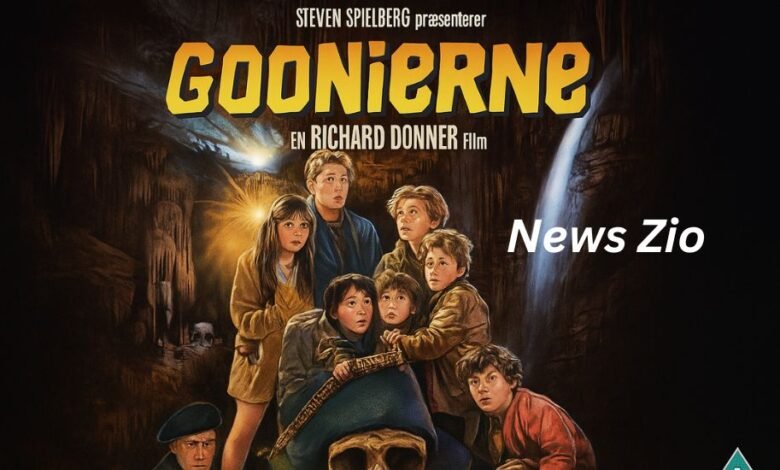Goonierne: The Legacy of The Goonies

Few films capture the timeless blend of adventure, humor, and heart like The Goonies. Released in 1985, this cult classic continues to inspire new generations. The term “goonierne” has become a curious online search variation tied to the movie, showing just how deeply the story resonates around the world. This article dives into the essence of The Goonies, addressing major questions fans and parents often ask: What are The Goonies about? Is The Goonies scary for kids? What disability did Sloth have? and What inspired the story?
What Are The Goonies About?
At its core, The Goonies is a story about friendship, courage, and the unbreakable bonds of childhood. Directed by Richard Donner, with a story by Steven Spielberg and screenplay by Chris Columbus, the film introduces us to a group of kids from the “Goon Docks” neighborhood in Astoria, Oregon.
Their lives are turned upside down when real estate developers threaten to foreclose their homes. Facing the loss of their community, the children—Mikey, Mouth, Chunk, Data, Brand, and their companions—embark on a desperate mission to find hidden treasure that might save their families.
The catalyst is a dusty old treasure map discovered in Mikey’s attic, pointing the way to the legendary loot of One-Eyed Willy, a pirate whose ship supposedly vanished centuries ago. What follows is a high-stakes treasure hunt filled with underground tunnels, booby traps, riddles, and a criminal family known as the Fratellis who are also after the gold.
But beyond the action, The Goonies is about identity and belonging. Each child has quirks and flaws, yet together they represent resilience against overwhelming odds. They discover that treasure is not just gold or jewels—it’s the loyalty and courage found in friendship.
Is The Goonies Scary for Kids?
When parents consider showing The Goonies to their children, the question of scariness inevitably arises. While the movie is rated PG, it was released before the modern PG-13 category became common, which means some of its content feels more intense compared to today’s PG films.
Elements That May Scare Kids
-
Villains: The Fratelli family, especially Mama Fratelli, exude menace. Their pursuit of the children involves threats, weapons, and dark humor that can unsettle younger viewers.
-
Dark Settings: Much of the story unfolds in underground caverns and abandoned places, creating a spooky atmosphere.
-
Traps and Danger: The elaborate booby traps set by One-Eyed Willy—falling rocks, spikes, and collapsing floors—create suspense that might be frightening.
-
Sloth’s Appearance: Sloth, though kind-hearted, has a distorted face and unusual behavior. Younger children might initially find his look disturbing.
Balancing the Fear with Fun
Despite these darker tones, The Goonies maintains a playful, adventurous spirit. The children crack jokes, argue like siblings, and rely on their wits to escape danger. These lighter elements reassure viewers that the heroes are capable of overcoming obstacles.
Age Recommendations
-
Ages 5–7: Some children may find the film too intense. The villains and darker scenes could lead to discomfort or nightmares.
-
Ages 8–10: Many kids will enjoy the sense of adventure but may still need parental guidance to understand the humor and mild swearing.
-
Ages 10+: Most children in this age group can handle the scares and will find the film thrilling, funny, and inspiring.
In short, The Goonies is best suited for older kids, but with parental support it can become a shared family adventure that sparks discussions about bravery, loyalty, and friendship.
What Disability Did Sloth Have in The Goonies?
Sloth, born Lotney Fratelli, is one of the most memorable and beloved characters in The Goonies. Despite being introduced as a terrifying figure chained in the Fratelli hideout, he soon reveals himself as a gentle soul who befriends Chunk and ultimately becomes a hero.
Sloth’s Portrayal
Sloth is depicted with significant physical deformities:
-
A misshapen skull with one eye drooping lower than the other.
-
Distorted features that give him a grotesque yet sympathetic appearance.
-
Immense physical strength contrasted with a childlike personality.
The In-Film Explanation
The movie suggests that Sloth’s appearance results from neglect and abuse—he was dropped multiple times on his head as a baby by his mother, Mama Fratelli. This fictional explanation paints him as a tragic victim of mistreatment rather than someone with a specific medical diagnosis.
Real-World Interpretations
Fans and medical observers have speculated about conditions Sloth might represent, ranging from craniofacial syndromes to developmental disabilities. However, filmmakers never confirmed any such intent. Instead, Sloth symbolizes the theme of not judging by appearances. Though others see him as monstrous, he displays kindness, courage, and loyalty far greater than many of the “normal” adults.
By the end, Sloth emerges as the ultimate outsider-turned-hero, showing that disability—real or fictional—does not define a person’s worth. His bond with Chunk underscores the film’s broader message: family can be chosen, and love transcends differences.
What Inspired The Goonies Story?
The world of The Goonies feels fantastical, yet parts of it draw from real-life history and Spielberg’s imaginative storytelling.
Spielberg’s Vision
Steven Spielberg conceived The Goonies as a cinematic adventure fueled by childhood curiosity. He wondered what would happen if a group of kids stumbled across a treasure map and embarked on a quest. Spielberg’s knack for blending wonder with danger turned the idea into a narrative that mixes pirate lore, hidden worlds, and suburban childhood.
Real-World Shipwrecks
Some historians point to actual maritime events along the Oregon coast as inspirations. The Santo Cristo de Burgos, a Spanish galleon that sank in the late 1600s, carried beeswax, silk, and porcelain. The so-called “Beeswax Wreck” sparked local legends of treasure washing ashore, which may have influenced the film’s central pirate myth.
Pirate Lore and Adventure Stories
The character of One-Eyed Willy draws from classic pirate legends—figures like Blackbeard and Captain Kidd. The idea of lost treasure hidden in elaborate caverns echoes stories passed down for generations, merging folklore with Hollywood spectacle.
The Universal Appeal
What makes The Goonies enduring is that it taps into a universal fantasy: the possibility that everyday kids could discover adventure right in their backyard. By weaving history, myth, and childlike imagination, the creators gave audiences a story that feels both magical and grounded.
The Enduring Legacy of “Goonierne”
The fascination with The Goonies endures decades after its release. Words like “goonierne,” sometimes used online as a search or playful misspelling, show how deeply the film has etched itself into cultural memory.
Beyond nostalgia, the movie remains relevant because it addresses timeless themes:
-
The power of friendship when facing overwhelming odds.
-
The courage of children in a world dominated by adult problems.
-
The reminder not to judge people, like Sloth, by appearances.
Whether introduced to new audiences or revisited by longtime fans, The Goonies continues to inspire dreams of treasure, adventure, and belonging.
Conclusion
The Goonies—or “goonierne” as some curious searches put it—remains a treasured piece of cinema. Its blend of pirate legends, thrilling adventure, and heartfelt character arcs ensure that it stands as more than just a film: it’s a cultural touchstone. For parents, the film provides a gateway to talk with kids about bravery, family, and acceptance. For fans, it’s a reminder of the magic of childhood imagination.
As we revisit its legacy, one thing is clear: The Goonies never say die.
Published on News Zio


